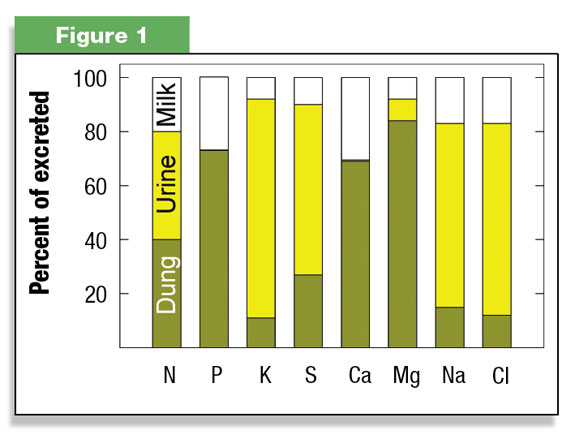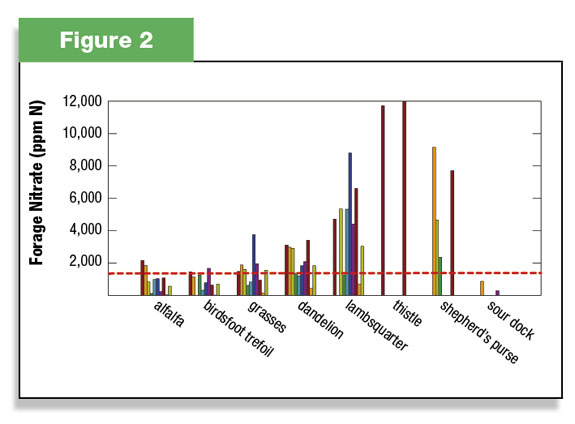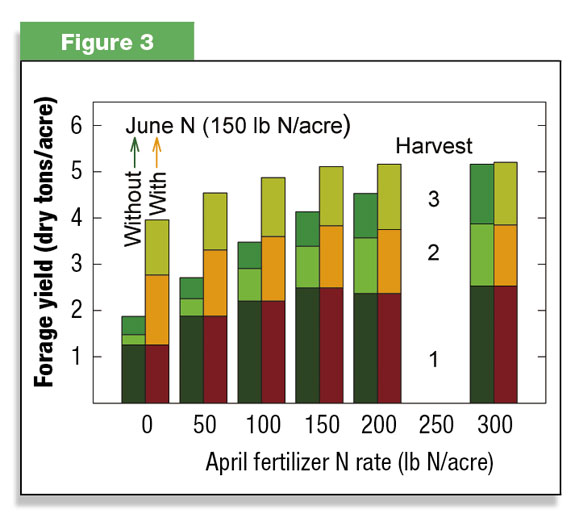In pasture, most of the nutrients harvested by livestock are returned. For example, six tons of hay may remove 300 pounds N, 40 pounds P and 250 pounds K from the field, whereas pastured beef may remove only 14 pounds N, six pounds P and two pounds K. In other words, most of what goes in the front end, comes back out.
The proportion of nutrients returned by livestock is directly related to the proportion of time the animals spend in pasture.
The more time the animals spend around watering tanks, shade and surface water, the higher the nutrient loading will be in those areas and the larger the pasture area will be that is nutrient-short.

The amount of return is related to the type of livestock and the quality of the diet. For example, growing beef cattle retain only 2 to 10 percent of the N, P and K they ingest, whereas lactating dairy cattle retain about the same amount but utilize 5 to 30 percent of the N, P and K for milk production (see Figure 1).
Dairy cows excrete the vast majority of what they eat, but as this figure shows, each element is voided in different proportions.
Milk is shipped off-farm and those nutrients do not return to the pasture.
The amount of each nutrient excreted in urine and dung varies tremendously. What does this mean for pasture fertility?
First, you can expect urine spots to recycle N, K, S, Na and Cl, whereas N, P, Ca and Mg are mainly returned in dung.
The proportion of N in urine compared to dung depends on the protein concentration of the total diet – the higher the protein, especially when it exceeds the animal’s requirement, the greater the amount of N excreted in urine.
But it’s also clear that those nutrients are not very evenly distributed. Why else would we wear rubber boots out there? The nutrient “application rate” in urine spots and dung pats are quite high.
For example, with grown beef animals, N, P and K rates average 450, 15 and 440 pounds per acre in urine spots and 930, 310 and 340 pounds per acre in dung pats.
As a result, we often see the crazy-quilt pattern of rapidly growing spots and shorter, less vigorous pasture. Some of that is due to avoidance of fouled herbage, but much has to do with high nutrient availability.
One concern, of course, is that excess nutrients are more liable to be lost by volatilization, leaching and runoff. Lost nutrients need to be replaced and can cause environmental problems.
To help prevent nutrient loss and to improve overall pasture productivity, animals need to be managed. Excreta distribution can be improved by moving watering sources, using portable shade, moving cross-fences and increasing stocking rate along with shortening the grazing intervals.

But high nutrient availability also can result in nitrate toxicity, grass tetany or milk fever.
Nitrate accumulates to hazardous levels in some species more frequently than in others (see Figure 2), and the risk of grass tetany is usually higher in grasses than legumes. In areas such as sacrifice paddocks or out-wintering paddocks, nutrient accumulation can be surprisingly large, raising the risk for animal well-being.
Now, let’s focus on the areas the excreta miss.
How do you know whether your pasture needs additional nutrients? Lack of vigor in desirable pasture plant species may indicate that one or more nutrients are lacking, or may be due to inadequate regrowth periods, droughty soils, strong preference by grazing animals, compaction or other causes.
Legumes typically require more P, molybdenum and boron than grasses. Weed encroachment signifies that the desired plants are not being favored by the management system.
Plant tissue testing may be used, but is tricky because nutrient concentrations change as plants grow. Seek reliable advice about what plant part and growth stage to sample, and follow proper sample handling for analysis.
It’s a good idea to separately sample areas you are concerned about and those affected by excreta.
Topsoil testing may show which nutrients are deficient, but this is reliable only for certain nutrients (P and K, for example).
Follow sampling instructions from your extension, company agronomist or co-op personnel and submit separate samples from problem areas and from areas where plant growth is good.
Pay special attention to soil pH, which affects availability of many nutrients and symbiotic N-fixation by legumes.
Nitrogen often is the most growth-limiting nutrient because it is lost from urine and dung by ammonia volatilization, nitrate leaching, denitrification and runoff.

Most pastures will respond well to N application. Spring growth is the most responsive to N, due to the cool-season grasses that dominate pastures in much of the humid U.S. You often can double the yield of pasture by fertilizing in very early spring (see Figure 3).
April N application doubled early season growth.
If the excess growth of forage in spring can be harvested (that is, if you have the time, equipment, help, dry weather and satisfactory field conditions), an early spring N application will usually produce the most forage.
More intensive stock management also may allow you to utilize much of the spring flush.
However, in this figure you also see how the three harvests were nearly equal when N application was delayed until June (zero N rate in April). This is a benefit when you depend on grazing to support the herd and want to avoid large swings in pasture productivity.
Remember that your profitability depends on efficient production of animal products, not just on forage yields. If you suspect or have evidence that one or more nutrients are lacking, try applying treatments in a few strips across the paddocks, so you can observe effects on pasture growth and grazing behavior. FG










